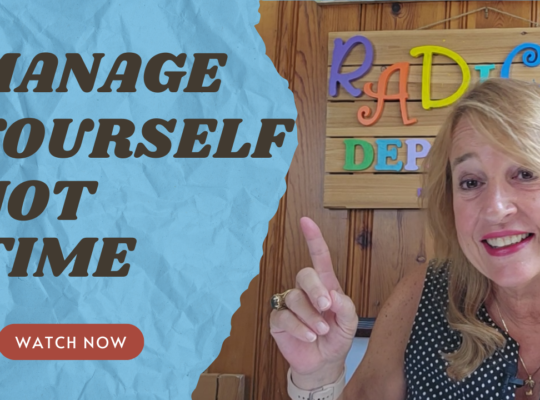“Leadership is the capacity to translate vision into reality.” – Warren Bennis
In today’s fast-paced business world, effective leadership goes beyond simply managing tasks and projects. It’s about inspiring your team and providing the right guidance to work toward a common goal. As a leader, your ability to align your team with a shared vision and empower them to take action can make all the difference in achieving success.
In this post, we’ll explore four essential building blocks to help you inspire and guide your team toward their goals, based on the insights from Angie Dobransky, business coach and founder of RAD Strategic Partners.
Communicate a Compelling Vision
One of the most critical elements of leadership is creating a vision that your team can rally around. It’s not just about setting a target, but helping people understand why that goal matters. When individuals are clear on why they’re working toward something, they are more invested in the outcome.
Think about the last time you worked on a project that had personal significance. You were likely more motivated and committed to seeing it through. That’s the power of a compelling vision—it taps into both the professional and personal motivations of your team.
As Angie shares in her experience at Liz Claiborne, her team wasn’t just building a jewelry brand; they were part of a movement that gave women confidence to step into the workforce with pride. That vision, fueled by passion and purpose, inspired the team to go above and beyond their goals.
Takeaway: When you set goals for your team, explain the bigger picture. Make sure your vision resonates on a personal level for each team member, and you’ll see a deeper commitment to achieving success.
Encourage Collaboration
Leadership is often mistaken for control. However, the most successful leaders understand that true power comes from empowering others. Rather than dictating every step of the process, encourage your team to collaborate and contribute their ideas. This not only fosters creativity but also gives your team a sense of ownership over the outcome.
In the video, Angie points out that when teams feel like they’ve had a hand in shaping the vision, they are naturally more motivated to achieve it. Collaboration also builds trust and accountability—two vital components of a high-performing team.
Takeaway: Foster an environment where everyone’s voice is heard. Invite your team to share ideas and solutions. When team members feel their contributions are valued, they become more engaged in the work and more driven to succeed.
Lead by Example
As a leader, your actions set the tone for the rest of your team. It’s not enough to simply talk about dedication and hard work; you need to demonstrate it in everything you do. When your team sees you consistently committed to the vision, they’ll be inspired to follow your lead.
Angie highlights this point when discussing the importance of enthusiasm. If you aren’t visibly excited about the vision you’ve set, it’s unlikely that your team will be either. By showing up with passion and dedication every day, you lead by example and model the behaviors you want to see in your team.
Takeaway: Be the leader you would want to follow. Show your team what true commitment looks like by consistently demonstrating dedication to the goal. Your example will inspire others to bring their best selves to work every day.
Provide Clear Guidance and Resources
Inspiration is essential, but it must be paired with clear guidance and the right resources to ensure your team can execute on the vision. As Angie explains, “Inspiration is the fuel, but guidance allows for execution.” Your team needs clarity on the steps they need to take and the tools to get there.
Without clear direction, even the most motivated teams can become frustrated or lose momentum. Make sure you provide detailed instructions, set clear milestones, and give your team the resources they need to be successful.
Angie also emphasizes the importance of providing the necessary tools to get the job done. If team members lack the skills, knowledge, or resources to move forward, they’ll struggle to achieve the desired outcome. Providing ongoing support and addressing obstacles as they arise is crucial for maintaining momentum.
Takeaway: Balance inspiration with execution. Once you’ve inspired your team, make sure they have a clear roadmap and the resources they need to succeed. Regular check-ins and feedback loops can also help ensure they stay on track.
Sustaining Motivation Over the Long Term
Achieving big goals takes time, and keeping your team motivated throughout the journey can be challenging. Angie advises two key strategies for maintaining motivation: first, keep the vision front and center. Regularly remind your team of the larger goal and celebrate small wins along the way to keep energy levels high.
Second, be transparent about setbacks. Every project will face obstacles, but your role as a leader is to help your team navigate those challenges without losing sight of the goal. Open communication about what’s working and what isn’t builds trust and resilience within the team.
Takeaway: Celebrate progress and keep the vision alive. Transparency about challenges shows that you’re committed to the team’s success, even when things don’t go as planned. This openness fosters a sense of unity and helps the team stay focused on the end goal.
Conclusion: Start Leading with Vision and Guidance Today
Great leadership isn’t about being in charge—it’s about inspiring your team and guiding them toward a shared goal. By following these four building blocks—communicating a compelling vision, encouraging collaboration, leading by example, and providing clear guidance—you can create a team that’s motivated, aligned, and ready to achieve greatness.
Whether you’re leading a project at work or managing a team in a different setting, start implementing these strategies today to unlock your team’s full potential. And don’t forget, effective leadership is a journey—one built through practice and dedication.
For more insights on leadership and personal development, be sure to watch the video above and subscribe to Angie Dobransky’s channel for future tips!
Action Steps for Effective Leadership:
- Communicate the Vision: Make sure your team understands the ‘why’ behind every goal.
- Encourage Collaboration: Foster an environment where team members feel their input is valued.
- Lead by Example: Demonstrate the behaviors you want to see in your team.
- Provide Clear Guidance: Give your team the resources and clarity they need to succeed.
By incorporating these steps into your leadership style, you’ll be well on your way to creating a high-performing team that works together toward achieving common goals.





